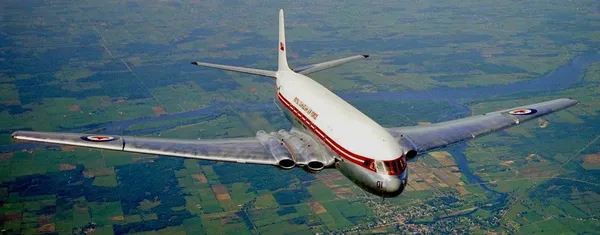Comet (Total: 2, Canadian: 2, Group 0)
de Havilland Comet

de Havilland DH.106 Comet, RCAF (Serial No. 5301).
The de Havilland DH.106 Comet was the world's first commercial jet airliner. Developed and manufactured by de Havilland at its Hatfield Aerodrome in Hertfordshire, United Kingdom, the Comet 1 prototype first flew in 1949. It featured an aerodynamically clean design with four de Havilland Ghost turbojet engines buried in the wing roots, a pressurised cabin, and large square windows. For the era, it offered a relatively quiet, comfortable passenger cabin and was commercially promising at its debut in 1952.
In March 1953, the RCAF received its first Comet. With the arrival of this aircraft, the RCAF became the first air force in the world to operate jet transports and the first operator to make scheduled trans-Atlantic Crossings.
However, within a year of entering airline service, problems started to emerge, with three Comets lost within twelve months in highly publicised accidents, after suffering catastrophic in-flight break-ups. Two of these were found to be caused by structural failure resulting from metal fatigue in the airframe, a phenomenon not fully understood at the time; the other was due to overstressing of the airframe during flight through severe weather. The Comet was withdrawn from service and extensively tested. Design and construction flaws, including improper riveting and dangerous concentrations of stress around some of the square windows, were ultimately identified. As a result, the Comet was extensively redesigned, with oval windows, structural reinforcements and other changes. Rival manufacturers meanwhile heeded the lessons learned from the Comet while developing their own aircraft.
Although sales never fully recovered, the improved Comet 2 and the prototype Comet 3 culminated in the redesigned Comet 4 series which debuted in 1958 and remained in commercial service until 1981. The Comet was also adapted for a variety of military roles such as VIP, medical and passenger transport, as well as surveillance; the last Comet 4, used as a research platform, made its final flight in 1997. The most extensive modification resulted in a specialised maritime patrol derivative, the Hawker Siddeley Nimrod, which remained in service with the Royal Air Force until 2011, over 60 years after the Comet's first flight. Wikipedia
Comet 5301, 1A / 1XB
s/n 5301
m/d DH.106
c/n 06017
5301
last update: 2024-December-25
1953-February-26 Taken on Strength 2022-02-07
1965-July-30 Struck off Strength 2019-08-20
Comet 5302, 1A / 1XB
s/n 5302
m/d DH.106
c/n 06018
5302
last update: 2024-December-25
1953-March-25 First Flight first flight 2019-08-20
1965-July-30 Struck off Strength 2019-08-20
 Comet Transport
Comet Transport Wikipedia Comet Transport
Wikipedia Comet Transport Harold A Skaarup Web Page
Harold A Skaarup Web Page RCAF Comet Serials Histories - Kestrel Publications
RCAF Comet Serials Histories - Kestrel Publications